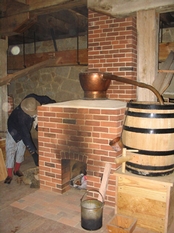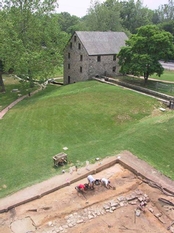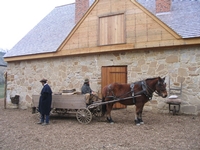With the 4th of July soon upon us it seems fitting to pay homage to the first president of our new nation, who deserves our gratitude not just for his military and political acumen, but also for his contribution to American spirits. What many people don’t know about George Washington is that he was both the father of our country and the father of American whiskey.
Washington is that he was both the father of our country and the father of American whiskey.
Like most early European settlers in America, Washington was not a stranger to hard liquor. Because wells, cisterns and even rivers had already been contaminated by runoff from privies or the waste from un-penned animals, clean drinking water was hard to come by. And because refrigeration and pasteurization hadn’t yet been invented, there really was no such thing yet as fresh fruit juice. Coffee and tea were occasional options for wealthier citizens, but these heavily taxed luxuries were too expensive and rare for most people. All of this left alcohol, with its purifying properties, as just about the only safe thing to drink.
Not surprising, then, that one of the principal goals of 17th century colonists was to establish a reliable supply of alcoholic beverages.
Beer had slaked the thirst of most of the world for eons, but early attempts to raise barley and hops in the new land were disappointing. Growing grapes for winemaking proved an even more unsatisfactory enterprise since native American grapes produced wines that did not appeal to most palates, while European vinifera species inevitably succumbed to American vine diseases. America’s earliest emigrants managed to produce reasonably palatable fermented brews from the native cornucopia of pumpkins, persimmons, maple syrup and even corn husks. The most successful beverages were made from apples, and fermented apple cider and brandy became household staples.
During the Revolutionary War General Washington supplied his troops with applejack, for like most people he was convinced that booze kept soldiers’ bodies warm, their digestions healthy and their spirits upbeat. In a letter to John Hancock he wrote that “benefits arising from moderate use of liquor have been experienced in all armies and not to be disputed.”
Mount Vernon’s farm manager, John Anderson, who had learned the art of distillation back home in Scotland, had long urged his boss to create a distillery at Mount Vernon. When he retired from politics, Washington decided to pursue the idea.
Washington established the distillery on one of his properties about three miles south of Mount Vernon. The building, completed in March 1798, was a 75 by 30 foot structure that housed five copper stills, a boiler, and fifty mash tubs. In the beginning, only corn and other grains from Mount Vernon’s own fields were used for the mash, but as demand grew, neighboring farmers provided him with additional grain in return for whiskey. By 1799, only two years after production had begun, Washington was probably the nation’s largest whiskey distiller, turning out 11,000 gallons of whiskey valued at $7,500.
Washington’s whiskey business was definitely a commercial venture: The entire production was purchased by twelve merchants in Alexandria, Virginia, who sold it in their retail establishments. The successful enterprise was short-lived, however, for Washington died two years after the stills were first fired up. A nephew inherited the distillery, but under his hand the business faltered and soon vanished altogether. The distillery fell into complete disrepair, and in 1814 burned to the ground.
In 1997, workers at Mount Vernon uncovered five copper stills and a few other artifacts that provided precise clues to Washington’s distillery  operations. In 2005, a team of archaeologists and other experts, funded by grants from the Distilled Spirits Council and the Wine and Spirits Council of America, began rebuilding a replica of George Washington’s distillery on top of its original foundation. The new distillery closely mimics the original operation, with a few concessions to 21st century building codes. At the new facility distillers demonstrate the methods Washington used to make whiskey. According to Mount Vernon officials Washington’s restored distillery is the only one in the United States that demonstrates authentic 18th century distillation techniques.
operations. In 2005, a team of archaeologists and other experts, funded by grants from the Distilled Spirits Council and the Wine and Spirits Council of America, began rebuilding a replica of George Washington’s distillery on top of its original foundation. The new distillery closely mimics the original operation, with a few concessions to 21st century building codes. At the new facility distillers demonstrate the methods Washington used to make whiskey. According to Mount Vernon officials Washington’s restored distillery is the only one in the United States that demonstrates authentic 18th century distillation techniques.
Most consumers who taste the whiskey find its appearance and flavors unfamiliar. While it’s impossible to know exactly what Washington’s whiskey tasted like, we can assume that his was a clear liquid since 18th century whiskey wasn’t aged in barrels (wood gives whiskey its color and certain flavor components). For a description of what the whiskey tastes like one might turn to David Pickerell, who led the team that made the first whiskey at Mount Vernon’s restored distillery. Pickerell, who was at that time the Master Distiller for Maker’s Mark Bourbon, published these tasting notes on the Internet:
whiskey tasted like, we can assume that his was a clear liquid since 18th century whiskey wasn’t aged in barrels (wood gives whiskey its color and certain flavor components). For a description of what the whiskey tastes like one might turn to David Pickerell, who led the team that made the first whiskey at Mount Vernon’s restored distillery. Pickerell, who was at that time the Master Distiller for Maker’s Mark Bourbon, published these tasting notes on the Internet:
Nose: Slightly floral, earthy, and grainy–reminiscent of freshly distilled Tequila.
Taste: Surprisingly sweet, but not overly so. Initial taste is primarily front palate. As the taste develops, it moves to the sides of tongue, revealing the un-aged grainy sourness. But again, not too sour. Finally the corn and rye grain tastes develop.
Finish: Fairly long and dry with the grain being most evident.
Overall: The taste is not nearly as aggressive as expected, surprisingly mellow and sweet.
7
